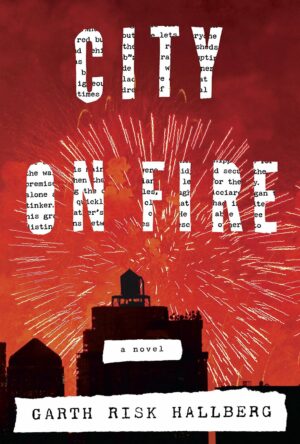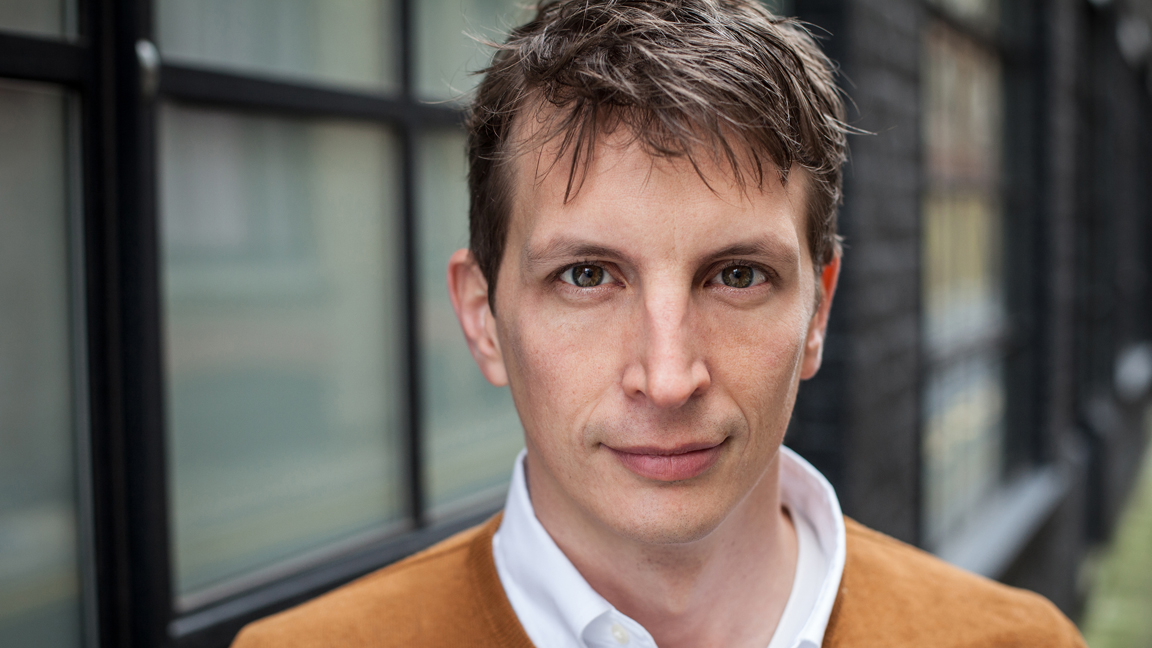The most powerful lyric in the history of rock and roll was written by Patti Smith. The first line of the first song on her first record—“Gloria,” from 1975’s Horses—both encapsulated the gospel-haunted history of rock and roll to that point and gave a kind of shape to the ensuing forty years.
“Jesus died for somebody’s sins, but not mine.”
There it all is, the spirit yawping behind Little Richard’s hammered keys and the establishment upon which the counterculture has always depended for its identity—and, surely, too, the postmodern idea that whatever is making life in the world possible for one person isn’t mutually exclusive with what’s making it possible for someone else. Smith’s lyric (a line with which, it must be said, she’s done battle over the years) scans as defiant but is ultimately confessional; you can fit a community in its eight words.
 Over its 900-plus pages, Garth Risk Hallberg’s debut novel, City on Fire, combusts the power inherent in “Gloria.” The novel is set in spring and summer of 1977 in New York City, amidst the final cracklings of punk’s initial bursting-forth. The city was, to put it bluntly, a hellhole, overrun by corruption and in default. The South Bronx was gutted by arson. The Lower East Side was a pit of anarchy both theoretical and non-. If you grew up in the 1980s, the New York City of the late ’70s cast a long and horrifying shadow; years before Giuliani cleaned up Times Square and gentrification turned the LES and Brooklyn into bobo havens, it was the pit of popular imagination, its millions of inhabitants crammed together in a Boschian squirm.
Over its 900-plus pages, Garth Risk Hallberg’s debut novel, City on Fire, combusts the power inherent in “Gloria.” The novel is set in spring and summer of 1977 in New York City, amidst the final cracklings of punk’s initial bursting-forth. The city was, to put it bluntly, a hellhole, overrun by corruption and in default. The South Bronx was gutted by arson. The Lower East Side was a pit of anarchy both theoretical and non-. If you grew up in the 1980s, the New York City of the late ’70s cast a long and horrifying shadow; years before Giuliani cleaned up Times Square and gentrification turned the LES and Brooklyn into bobo havens, it was the pit of popular imagination, its millions of inhabitants crammed together in a Boschian squirm.
I was not alive then. Nor was Hallberg, who was born outside of Baton Rouge and grew up in rural North Carolina, not moving to New York until he was well into his twenties. But it’s hard to shake the feeling that something about his novel feels right, as critics older and more seasoned than I have already said. Hold City on Fire for long enough and you begin to feel as though axle grease is covering your hands, that a mild breeze might blow some rancid crumple of trash out of the book and into your lap.
The novel is largely set in the East Village (though several of its twining plots lead us to Central Park West), and many of its characters are rabid participants in the curdling scene, but Hallberg does not canonize. With the exception of Smith, who exerts a heavy influence on the proceedings here, very few of the major heroes of the era are directly referenced. CBGB’s is virtually absent, as are The Ramones and Television. Talking Heads are indirectly alluded to in a toss-away line about a band from RISD.
Instead we’re given St. Mark’s Church-in-the-Bowery, the longtime haven for artists where Smith first performed “Oath,” the poem that would eventually become “Gloria.” Our characters aren’t overly indebted to the mookish thrust of “The Blitzkrieg Bop” but to the ideas of the fictional proto-punk band Ex Post Facto, whose lead singer, William Hamilton-Sweeney, gives up punk rock for painting and heroin. The cultish Nicky Chaos, who replaces Hamilton-Sweeney (nom de rock: Billy Three-Sticks) in Ex Post Facto and rechristens the group Ex Nihilo, begins a theoretical movement he calls “post-humanism” and spouts Situationist philosophy for the edification of his young followers, including Charlie Weisbarger, a Long Islander who follows a beautiful neighborhood girl into the Lower East Side and out of the suburban idyll.
In other words, City on Fire’s punk is more a movement of the mind than the body. To be sure, there is some basis to this idea, as Jon Savage’s clinical dissection of the British scene, England’s Dreaming, demonstrates in great detail. And while City on Fire’s eschewal of New York punk’s biggest names gives Hallberg the freedom to draw the scene free from the historical baggage his readers would necessarily bring to the text, it’s hard to shake how heavily the novel leans on punk as an idea or, to be frank, a system of belief. It’s to the detriment of the movement’s visceral power, its ability to make you feel, without which its ideas would never have gotten off the ground. One scene set in a club aside, people don’t seem to have much fun listening to this music, which seems like the kind of historical imagining only a former critic like Hallberg might undertake.
City on Fire’s punk is more a movement of the mind than the body.
Which is not to say that City on Fire is lacking in physicality or specificity. Even when they’re drawn from the monolithic stables of the Great American Male Novel Stockyards, Hallberg’s characters are fully realized, fully human; it’s to his great credit that Keith Lamplighter, the requisite middle-aged, upper-class man who commits an affair with a younger woman (Samantha Cicciaro, the same Long Island punk whose effervescence nearly wrecks young Charlie’s life) is drawn with a level of nuance that renders him not totally detestable, tired though his storyline may be.
Like Infinite Jest, whose influence Hallberg has cited, City on Fire is built around a massive cast, and just as David Foster Wallace sets all of his characters’ paths toward the necessity of learning to believe in something greater than the self, nearly every character in City on Fire is in search of a life less sullied by the checks other people’s existences—and their subsequent desires and motives and actions—exert on their own; whether that’s a good impulse or bad depends on who’s being checked and how, but everyone here lives in a state of lamentation that the limits of the horizon are arranged the way they are. The sprawling world pushes itself on these characters; rarely (for much of the novel, at least) do they push back.
Except for Samantha. We barely know her. She’s shot in the novel’s opening movement, and spends the next seven-hundred-and-fifty pages on life support. The question of who shot her and why is the central plot, the fountain from which “Gloria” springs into City on Fire’s world. What we know of her is through the witness of those who love her: the way she liberated Charlie from his suburban ennui (and how, without her guidance, he is utterly hopeless); how her refusal to have her body commodified by Keith or Nicky Chaos bred in her a new kind of power, and how that power in turn left her alienated; how her inevitable teenhood left her cuckolded father behind, forever struggling in her wake.
Late in the novel, she’s visited by an apparition. It appears to be Patti Smith, though she at once resembles Samantha’s mother. And Patti/Mom delivers a kind of invitation disguised as an ultimatum—or an ultimatum disguised as an invitation—to give herself up, to give her life away. To risk death and the loss of everything for the sake of her father, and Charlie, and Keith, and the city itself. “Sam could move upward into the blackness, or down into the vista,” our narrator says, referring to the small life of the world around her, “but the moment was fast approaching when loitering in between would no longer be permitted.”
In the end, then, it’s only Samantha—only by way of Patti, only by way of her mother, only by way of some unnamed haunting force—who has even a shot of righting the course. “What I’m telling you, honey, is that you, personally, can only apply for an exemption for one or the other,” the spirit tells her. The choice Samantha is given—to risk herself for the sake of the world or to protect her own life—is something to which she can only apply. There is no guarantee that everyone will be brought to rights. But the choice will be hers. She’ll have to choose whether or not to die. FL







